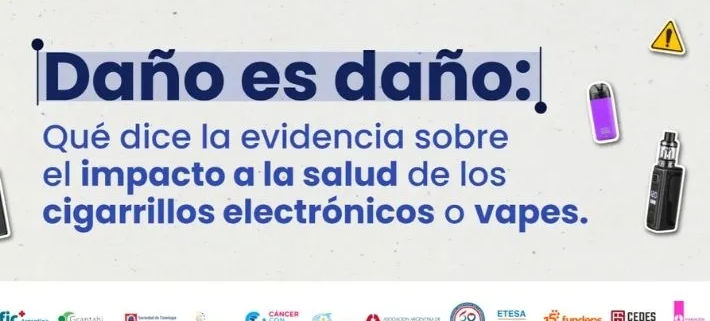Harm is harm: the impact of electronic cigarettes on health.
Tobacco use continues to be one of the main risk factors for disease, disability, and preventable death in Argentina. Meanwhile, the tobacco industry is shifting its strategy toward new products—such as electronic cigarettes and heated tobacco products—in an effort to maintain its market and evade existing regulations.
In response to this situation, the InterAmerican Heart Foundation (FIC Argentina), together with AsAT, ETESA IECS, GRANTAHI from the Italian Hospital, UATA, FEIM, Fundeps, Fundación Sales, Fundación Pacientes Cáncer de Pulmón, and CEDES, developed the document “Emerging products and health damage: Situation in Argentina and recommendations.” Its aim is to systematize the available scientific evidence and propose concrete measures to protect public health.
Current scientific evidence shows that emerging products are not harmless. A recent meta-analysis found that the risk of cardiovascular disease, stroke, and metabolic dysfunction is similar between users of electronic cigarettes and those who smoke conventional cigarettes. In addition, other reviews have reported links to pneumonia, bronchitis, decreased sperm count, dizziness, headaches, migraines, and oral cavity damage. The document also highlights that dual use (electronic and conventional cigarettes) increases disease risk, and that studies suggesting otherwise often come from authors with conflicts of interest.
A gateway to tobacco use:
Available data in Argentina are clear:
- According to the Global Youth Tobacco Survey (2018), 7.1% of adolescents aged 13 to 15 used electronic cigarettes.
- A more recent survey conducted in 2023 by FIC Argentina found that 8.9% of adolescents in Buenos Aires are current users of these products.
These results confirm that emerging products can serve as a gateway to tobacco use, even among adolescents who had never smoked before.
No more, no less—just another form of harm:
The most accurate way to understand the impact of vaping is as a different risk, not necessarily a lower one.
A true harm reduction strategy should be implemented by health authorities, aim to protect public health, and focus on specific groups—not rely on the free commercialization of harmful products.
The signatory organizations recommend:
- Strengthening the enforcement of current regulations.
- Coordinating actions among public agencies to improve oversight and sanctions.
- Promoting cooperation with civil society organizations free from conflicts of interest to reduce tobacco and nicotine use.
Electronic cigarettes are not a safe alternative. They pose a different kind of risk, with growing evidence of their impact on health and their role in initiating tobacco use. Protecting the health of the population—especially children and adolescents—requires decisions based on independent evidence, free from industry influence.
Read the full document at LINK.











